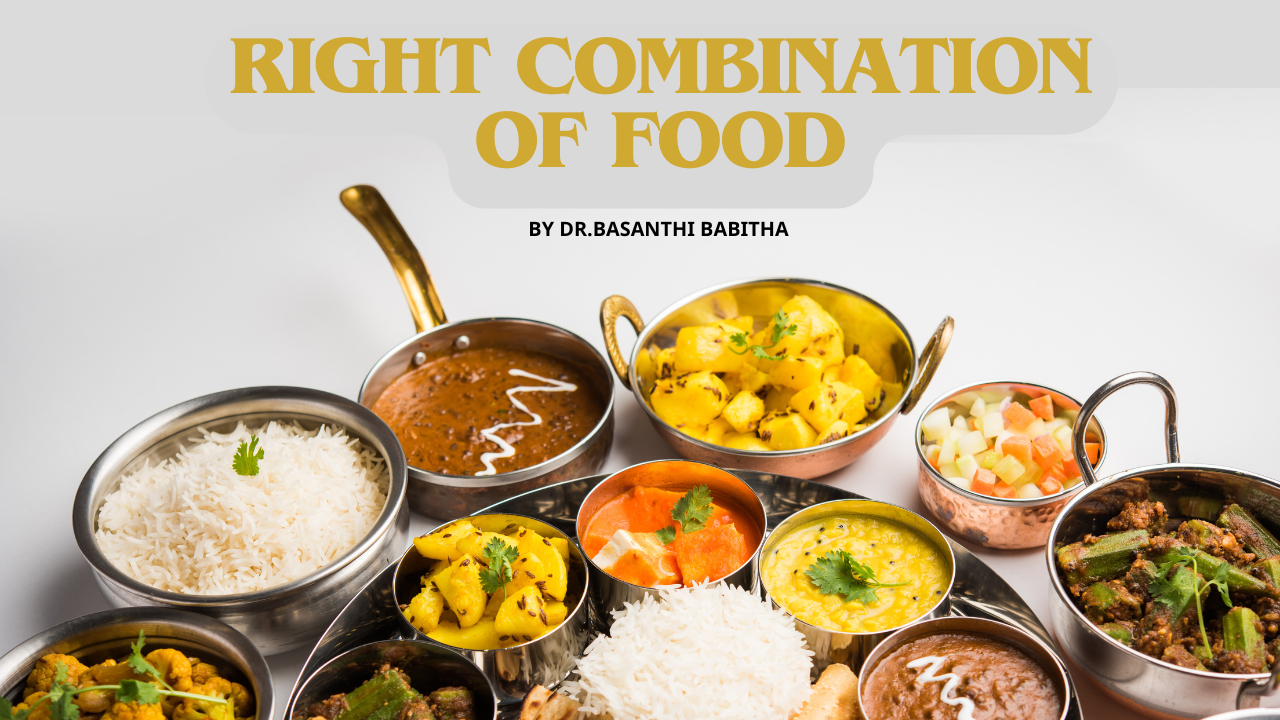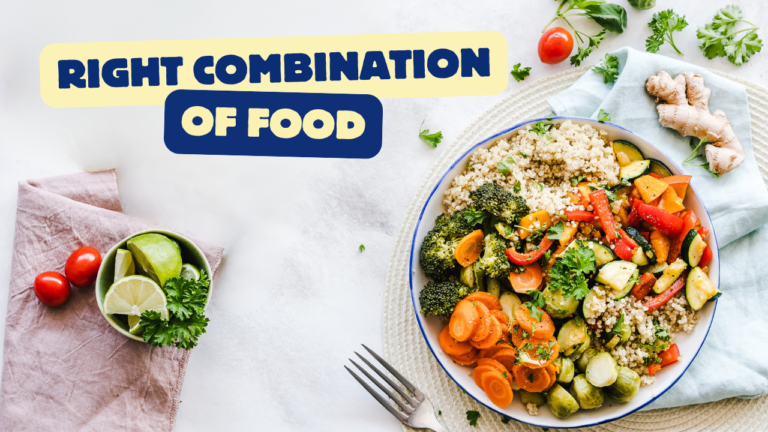RIGHT COMBINATION OF FOOD BY DR.BASANTHI BABITHA
Understanding the Right Combinations of Food
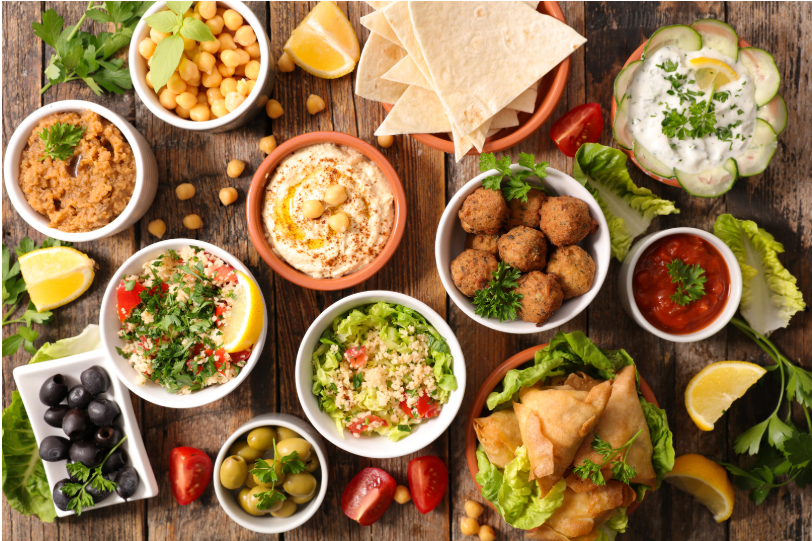
The topic of discussion today revolves around the right combinations of food. Can anyone share their understanding of this concept? Do you have any ideas about the right or wrong combinations of food?
One participant mentioned that in a previous lecture, certain food combinations were discussed. Some combinations are beneficial for the body, while others might cause adverse reactions in the gut or stomach. These reactions could impact overall health. For instance, milk and salt in their pure forms do not make a good combination. Such combinations are often found in dishes like white sauce, which includes both milk and salt. Another example discussed was rice and vinegar, which is also considered an unfavorable combination.
Additionally, mixing fish with curds was highlighted as another potentially unsuitable combination. However, it was noted that the effects of these combinations might vary from person to person. What may not suit one individual could work well for another, depending on their unique system.
Factors to Consider:
Before labeling a combination as right or wrong, several factors must be considered. This is not just about general assumptions but requires a deeper understanding of food interactions. A detailed analysis helps to identify whether a particular combination is suitable or not.
Exploring Food in Detail:
To begin, we need to explore food comprehensively, starting with its definition, nutrition, and functions. This includes studying the types of food and their subdivisions. Additionally, principles and factors outlined by dietary associations should be considered to determine right and wrong combinations.
Naturopathy plays a significant role in deciding suitable combinations. It provides a framework to assess dietary choices holistically, considering an individual’s medical history and lifestyle.
The Need for Research:
This topic is vast, and even though a brief overview has been provided, further research is encouraged. Each individual can investigate different combinations to gain deeper insights. This is especially important as food combinations often depend on personal health conditions and dietary requirements.
Customizing Diets for Optimal Health:
Ultimately, the goal is to decide on the right or wrong combinations of food by considering various factors. This allows for the creation of customized diets tailored to an individual’s medical needs or their preference for a healthy lifestyle.
Before making any dietary decisions, it is essential to delve into the details and provide a person-specific diet plan. This ensures that the combination of foods supports their health and well-being.
Understanding Food: Definition and Importance

Food is a vital component of life, essential for the nourishment and maintenance of the body. Below are key points explaining its definition and significance:
- Definition of Food:
- Food is anything that is eaten or drunk to meet the body’s needs for energy, growth, regulation, and protection.
- It acts as the raw material from which our bodies are built.
- Purpose of Food:
- Energy: Provides the fuel required for all bodily functions and activities.
- Bodybuilding: Supports the growth, repair, and maintenance of tissues.
- Protection: Strengthens the body’s immune system to ward off diseases.
- Quantity and Appearance:
- Food refers to the tangible quantity of what we eat, as seen on our plates.
- The impact of food intake is evident in our external appearance, physical efficiency, and emotional well-being.
- Right Combinations and Balance:
- Consuming the correct types, combinations, and amounts of food ensures good nutrition.
- Proper nutrition promotes health, enhances performance, and uplifts mood.
- Connection Between Food and Nutrition:
- Food represents the material consumed, while nutrition refers to the process and effects of how the body utilizes it.
- A well-balanced intake can visibly reflect positive health and vitality.
- Impact on Life:
- Food directly influences physical health and internal systems.
- A nutritious diet supports an individual’s overall quality of life, evident in their appearance and emotional stability.
In summary, food is the foundation of good health. Choosing the right kinds and quantities can enhance both our physical and mental well-being, making it essential to prioritize a balanced and mindful diet.
Understanding Nutrition and Balanced Diet
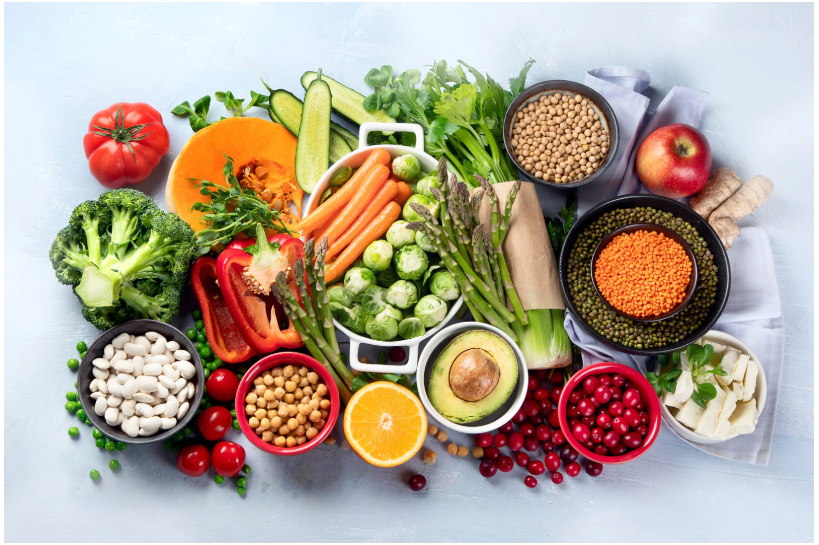
Nutrition is a fundamental aspect of maintaining a healthy and fulfilling life. It goes beyond just eating food—it’s about understanding the quality and role of nutrients in supporting our body’s various functions. Let’s explore the definition of nutrition, its components, and the concept of a balanced diet.
What is Nutrition?
- Definition:
Nutrition refers to the vitamins, minerals, proteins, and other essential components present in food. It is not merely about the quantity of food consumed but focuses on its quality. - Key Concept:
Nutrition is often defined as “food at work in the body.” It encompasses everything that happens to food from the time it is eaten until it is utilized for various functions such as growth, repair, and energy production. - Functions of Nutrition:
- Growth: Helps in the physical development of the body.
- Reproduction: Supports reproductive health and processes.
- Healthy Living: Maintains overall physical and mental well-being.
Components of Nutrition:
- Macronutrients:
- Carbohydrates
- Proteins
- Fats
- Micronutrients:
- Water
- Minerals
- Vitamins
- Importance of Essential Nutrients:
There are over 40 essential nutrients supplied by food, which are used to produce thousands of substances necessary for life and physical fitness. - Plurality in Nutrients:
The human body requires various nutrients such as vitamins and minerals in adequate amounts. It is not about a single nutrient like “vitamin” but a combination of “vitamins,” “minerals,” and other essentials.
Balanced Diet:
- Ideal Composition:
A typical balanced diet is often represented as:- 40% from fruits and vegetables
- 25% from fiber-rich carbohydrates
- 25% protein
- 10% fats
- Factors to Consider:
These percentages are not fixed for everyone. The ideal composition varies based on several factors:- Activity Level:
- For individuals with heavy physical activity, the carbohydrate and protein intake should be increased to meet energy demands.
- Lifestyle:
- Sedentary or moderate lifestyle individuals may require different ratios of nutrients.
- Medical Conditions:
- People with conditions like kidney issues may require specific adjustments, such as reducing protein intake and including high biological value protein.
- Activity Level:
- Personalization of Diet:
- A balanced diet must be tailored to each individual based on their physical activity, health status, and other factors like climate and environment.
- For instance, someone from a particular region or climate might need different nutrients compared to another.
- Online counseling further highlights the need to understand a person’s background, food preferences, and living conditions before deciding their diet.
- Dynamic Nature of Nutrition:
Nutrition percentages and requirements can change depending on factors such as geographical location, lifestyle, and environmental conditions.
Nutrition and a balanced diet are critical for overall well-being. While general guidelines exist for nutrient distribution, every individual requires a personalized approach based on their unique needs. Understanding the importance of macronutrients and micronutrients, along with adapting diets to specific circumstances, is key to achieving optimal health and fitness.
Understanding Food: Functions, Types, and Physiological Impact
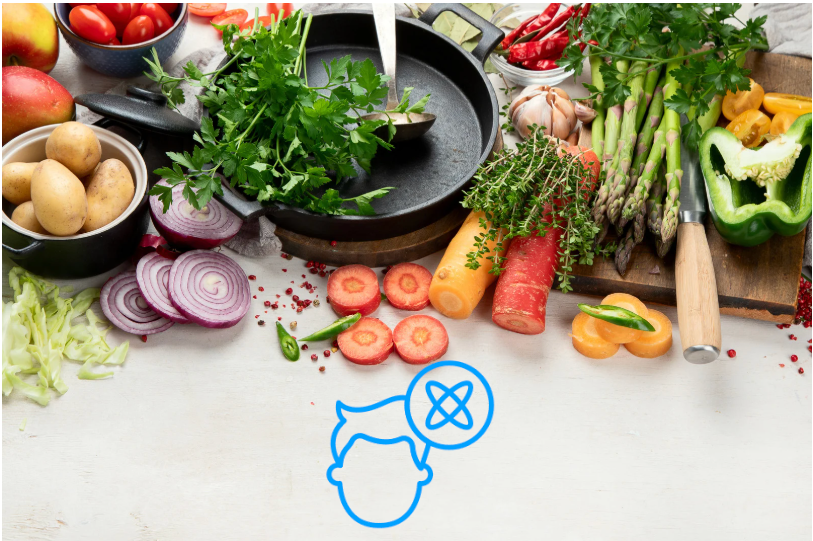
Food is fundamental for human survival and health. Beyond its basic purpose of satiating hunger, food plays an intricate role in ensuring our bodies remain active, resilient, and functional. Let us explore the functions of food, food combinations, types of food, and the physiological effects they have on our bodies.
Functions of Food
Food serves several critical functions for the body:
- Energy and Activity
It fuels our body to stay alive, work, and remain active. Without the right energy, our body cannot sustain daily activities effectively. - Growth and Repair
Food provides nutrients for building new cells and tissues, facilitating growth and recovery from wear and tear. It enables the body to heal itself. - Immunity and Health
Proper nutrition strengthens the body to fight infections and prevent illnesses, ensuring overall well-being. - Maintenance of Physiological Balance
Balanced food contributes to the formation of new cells while older cells are naturally discarded, ensuring the body’s optimal function.
Food Combining: A Simple Approach
Certain food combinations enhance nutrient absorption and digestion. Here are some general guidelines:
- Fruits: Best consumed alone on an empty stomach for optimal digestion. Examples include apples, bananas, berries, and melons.
- Starches: Pair well with cooked non-starchy vegetables. Foods like grains, bread, and potatoes fall under this category.
- Proteins: Items such as eggs, cheese, yogurt, milk, and fish are better digested with non-starchy vegetables.
- Nuts, Seeds, and Dried Fruits: These should be eaten raw or slightly dried, such as almonds and dried coconut.
- Neutral Foods: Lemons, lime, butter, oils, and coconut water can be paired with any category, enhancing vitamin and mineral absorption.
Types of Food
Food can be broadly classified based on its function and role in the body:
1. Energy-Giving Foods
- Rich in carbohydrates, fats, and proteins, these foods provide the energy needed for physical and mental activities.
- For example, one gram of carbohydrate or protein provides approximately 4 kilocalories, while one gram of fat provides 9 kilocalories.
2. Body-Building Foods
- These support growth, repair, and maintenance of body tissues. Foods rich in protein, such as milk, eggs, fish, and legumes, fall under this category.
3. Protective and Regulatory Foods
- These foods provide essential vitamins and minerals, boosting immunity and regulating body functions. Examples include fruits, vegetables, and nuts.
Physiological, Psychological, and Social Functions
Food not only nourishes the body but also plays a significant role in our mental and social well-being:
- Physiological Functions
- Energy provision, growth facilitation, and disease prevention.
- Psychological Functions
- Food influences mood, emotions, and mental clarity, making it a comfort and a source of satisfaction.
- Social Functions
- Food fosters cultural and social bonding, being central to gatherings, traditions, and celebrations.
Understanding the interplay of food types, combinations, and their physiological effects is essential for a healthy life. Food is not just about consumption; it’s about making mindful choices tailored to individual needs, lifestyles, and health goals. Through proper nutrition, we can achieve a harmonious balance of energy, growth, and well-being.
The Role of Protein and Nutrients in Bodybuilding and Overall Health

In the realm of bodybuilding, protein plays a major role in muscle growth and recovery. However, not all proteins are created equal, and understanding the differences between various types can help maximize the benefits for athletes, bodybuilders, and health-conscious individuals alike.
1. Types of Protein: High vs Low Biological Value
- High Biological Value Proteins (HBV): These are proteins that are easily absorbed and utilized by the body in high percentages. Foods like eggs, milk, meat, and fish are examples of high biological value proteins. When these foods are properly cooked and consumed in adequate amounts, they provide the necessary amino acids for muscle growth and repair.
- Low Biological Value Proteins (LBV): These proteins are more challenging for the body to absorb, typically being absorbed in much lower percentages (around 50%) than their high biological value counterparts. Foods such as pulses, oilseeds, and nuts fall into this category. While they do contain protein, they may not provide all the essential amino acids needed by the human body.
2. Nutritional Functions of Food
Food has two main functions in the body: building the body and regulating body functions.
- Building the Body: Protein is essential for the synthesis of body tissues, particularly in muscle growth and repair. The proteins found in animal products like eggs, meat, and fish are particularly valuable because they provide all the essential amino acids in the right proportions.
- Regulatory Function: Nutrients like vitamins and minerals help maintain various physiological functions such as heartbeat regulation, water balance, and body temperature. These are crucial for protecting the body from infections and maintaining overall health. Protective foods can be classified into two categories:
- High Biological Value Proteins: These include foods such as milk, egg, fish, and liver, which are rich in both protein and essential vitamins and minerals.
- Green Leafy Vegetables and Fruits: These foods provide a wealth of vitamins and minerals but are typically low in protein. However, they are essential for fighting diseases and infections.
3. Vegetarian vs Non-Vegetarian Protein Sources
For vegetarians, it can sometimes be more challenging to get enough complete proteins since plant-based proteins may lack certain essential amino acids. Thus, vegetarians often need to turn to supplements or protein powders to ensure they’re getting the full range of amino acids. Common plant-based sources of protein include pulses, oilseeds, and nuts, but these require careful dietary planning to ensure they are balanced with other nutrient-rich foods.
- For Non-Vegetarians: Animal-based proteins are typically complete, providing all the essential amino acids and making it easier for the body to use the protein effectively. However, it’s important to avoid improper cooking methods, such as deep frying, which can reduce the biological value of proteins.
4. Vitamins and Minerals for Health
Vitamins and minerals are critical for maintaining a healthy body, and they play a crucial role in regulatory functions. For instance, the B-vitamins, particularly B6 and B12, are essential for the body’s energy production and nerve function.
- B6 and B12: These vitamins are predominantly found in animal products such as meat, eggs, and fish, making them difficult for vegetarians to obtain through plant-based foods alone. Therefore, vegetarians may need to rely on supplements for adequate intake.
- Other B Vitamins (B1, B2, B3): These vitamins are more readily available in plant-based foods like green leafy vegetables and fruits.
5. Psychological Impact of Nutrition
Food does not just nourish the body; it also affects mental and emotional well-being. The psychological state of a person can have a significant impact on their ability to digest and absorb nutrients.
- Emotional and Psychological State: A person who is anxious, depressed, or stressed may not be able to properly digest or absorb the nutrients from their food, even if the food is highly nutritious. It’s important to consider the individual’s mood and psychological state when planning a diet or nutrition regimen.
- Digestive Health: Proper digestion is essential for nutrient absorption. If a person is stressed or in a negative emotional state, it can lead to poor digestion, meaning the body won’t fully benefit from the nutrients in the food consumed.
Food plays a multifaceted role in maintaining and improving health. It is not just about the quantity of protein or nutrients consumed, but also about the quality and the balance of foods in the diet. Whether you’re a bodybuilder looking to maximize muscle growth or simply striving for overall health, understanding the various types of proteins and nutrients and how they work in the body can help you make more informed dietary choices. Additionally, emotional and psychological factors must be considered, as they can significantly impact digestion and nutrient absorption.
To achieve optimal health, it’s essential to choose a varied diet that includes both animal and plant-based protein sources, vitamins, and minerals. With careful planning, anyone can meet their nutritional needs and support their physical and mental well-being.
Understanding the Right Food Combinations for Optimal Health

Food plays a critical role in our daily lives, and understanding the functions and types of food is essential for maintaining a healthy lifestyle. Food can have various physiological, psychological, and social effects, and knowing the right combinations can maximize its benefits. Let’s break down how the right combinations can contribute to your health.
1. Understanding the Functions of Food
Food can serve different functions for the body:
- Energy-giving: Providing the fuel needed for daily activities.
- Bodybuilding: Helping in tissue repair and growth.
- Protective: Preventing diseases and boosting immunity.
The types of food can be categorized into high biological value (HBV) and low biological value (LBV). Combinations of these foods should be tailored to the individual’s body type and needs, ensuring optimal health.
2. The Importance of Food Combinations
- Customizing combinations: A good food combination ensures that your body gets the necessary nutrients in a way that it can easily absorb. For example, pairing energy-giving foods with bodybuilding nutrients can provide sustained energy while aiding in muscle repair.
- Suiting body types: The right combinations may vary based on body type. What works for one person may not necessarily work for another, and thus a personalized approach is essential.
3. Sample Diet Chart and Combinations
A good diet should combine various nutrients in the right proportions, ensuring you get the benefits from each type of food. Here is a sample diet chart with some simple yet effective combinations:
Early Morning Options:
- Warm water with lemon: Starting the day with warm water and lemon helps detoxify the body. You can add seeds or nuts like almonds, walnuts, fenugreek seeds, or flaxseeds.
- Nuts and oil seeds: Adding healthy fats through nuts or seeds can provide long-lasting energy.
- Variation: Not every option suits every person, so some may prefer flaxseeds while others might find fenugreek more beneficial.
Breakfast Ideas:
- Ragi, Broken Wheat, and Oats: These complex carbohydrates can be combined with milk, which adds protein and makes the meal more nutritious.
- Idli with sambar and chutney: Idli is made from a combination of pulses and rice, which is low in biological value but can be absorbed effectively when steamed. The combination of sambar (protein) and chutney (vitamins) provides a balanced meal.
- Dosa with sambar and chutney: Similar to idli, dosa provides a good mix of carbohydrates and proteins.
4. Lunch and Other Meals:
- Vegetables and Buttermilk: Vegetables are rich in vitamins, while buttermilk provides essential amino acids. This combination is ideal for a balanced meal.
- Boiled Eggs: Adding eggs increases the biological value of the protein in the meal. Eggs are a good source of high biological value protein, which is essential for the body.
Snack Options:
- If you’re missing some essential nutrients in your main meals, snacks can help fill the gap. For example, you could snack on iron-rich foods like pomegranate or rice to boost iron intake.
5. Cooking Methods Matter
How food is cooked is equally important as what you eat. For example:
- High biological value protein from meat, fish, or chicken can lose its benefits if over-fried or cooked improperly.
- Similarly, pulses, though low in biological value, can become more nutritious when cooked properly, like in the case of steamed idli.
6. Combining Nutrients for Maximum Effect
- Combining complex carbohydrates (like ragi or oats) with protein-rich foods (like milk or eggs) can give you a well-rounded meal.
- Include a variety of fruits, vegetables, and vitamin-rich foods in your snacks and meals to fill any nutritional gaps.
Food is not just about eating to fill up; it’s about providing the body with the right nutrients in the right combinations. By understanding how different foods work together, you can ensure your meals are nutritious, well-balanced, and tailored to your body’s needs. Always keep in mind the importance of customization, cooking methods, and food variety for achieving a healthy lifestyle.
The Importance of Holistic Health: Embracing Seasonal Eating and Nature’s Bounty

As we transition through different seasons, particularly from autumn (Sharad Rutu) to winter, it’s essential to pay attention to our health, both mentally and physically. One of the most effective ways to enhance overall well-being during this time is by embracing holistic health practices, which focus on nourishing the body, mind, and spirit. In this article, we will explore the importance of seasonal eating and how nature’s bounty can improve our health.
Understanding Holistic Health:
Holistic health goes beyond just the absence of illness; it involves treating the whole person, not just the symptoms. It emphasizes balance, wellness, and the interconnectedness of the physical, emotional, and spiritual aspects of life. In naturopathy, holistic health is central to maintaining long-term wellness.
Key Aspects of Holistic Health:
- A balance between physical, mental, and emotional health.
- Connection to nature and the environment.
- A focus on prevention, not just treatment.
- Nourishing food choices that align with natural cycles.
Seasonal Eating: A Key to Health During Sharad Rutu (Autumn):
Autumn, known as Sharad Rutu, is a season of transformation. The body requires extra care during this period as the weather shifts and our immune systems may weaken. Seasonal eating helps strengthen the body’s natural defenses, as the foods available during this time are best suited to balance out seasonal changes.
Benefits of Seasonal Eating in Autumn:
- Boosts Immunity: Eating seasonal foods, such as pumpkins, sweet potatoes, and carrots, helps increase immunity due to their rich antioxidant content.
- Enhances Digestion: Autumn is a great time for root vegetables that improve digestive health, as they are warm and nourishing.
- Balances Body Temperature: The warming properties of autumn foods, such as cinnamon, ginger, and cloves, keep the body warm and energized.
- Supports Mental Clarity: Seasonal vegetables like cabbage and kale contain nutrients that help with mental focus and clarity, which are crucial as the days shorten.
Nature’s Bounty: What to Include in Your Autumn Diet
Autumn brings an array of fresh produce, herbs, and spices that are perfect for nourishing the body during this season. Nature’s bounty during this period offers a variety of health benefits that help maintain balance and well-being.
Autumn Foods to Include:
- Leafy Greens: Spinach, kale, and mustard greens are packed with vitamins and minerals that support overall health.
- Root Vegetables: Beets, carrots, and sweet potatoes are excellent for digestive health and maintaining energy levels.
- Nuts and Seeds: Almonds, walnuts, and sunflower seeds provide healthy fats and support brain function.
- Fruits: Apples, pears, and pomegranates are rich in fiber and antioxidants that help detoxify the body.
- Herbs and Spices: Turmeric, cinnamon, and ginger are particularly beneficial in the autumn for their warming and anti-inflammatory properties.
The Role of Naturopathy in Holistic Health:
Naturopathy plays an essential role in holistic health by focusing on natural remedies, preventive care, and individualized treatments. Naturopathy encourages the use of plant-based medicines, dietary adjustments, and lifestyle changes to restore balance within the body.
How Naturopathy Supports Holistic Health:
- Detoxification: By incorporating seasonal foods that cleanse the body, naturopathy supports detoxification, helping to remove toxins from the system.
- Stress Reduction: Practices such as meditation, yoga, and herbal teas help reduce stress, an essential part of holistic health.
- Personalized Care: Naturopathy considers individual body types and unique health needs, offering personalized care tailored to each person.
How to Apply Holistic Health Practices to Your Routine:
To reap the benefits of holistic health and seasonal eating, consider incorporating the following tips into your daily routine:
- Start Your Day with Warm Water and Lemon: This simple morning ritual aids digestion and boosts immunity.
- Incorporate Seasonal Vegetables into Every Meal: Focus on consuming fresh, seasonal produce in soups, salads, and stir-fries.
- Practice Mindfulness and Meditation: Taking time each day for mindfulness practices helps reduce stress and enhance emotional health.
- Prioritize Sleep: As the days become shorter, ensure you get quality rest to support overall well-being.
- Stay Active with Gentle Movement: Incorporate yoga, walking, or stretching to keep your body energized and balanced.
Embracing holistic health practices and seasonal eating can profoundly improve your overall wellness, especially during the transition to autumn. By aligning your diet with nature’s bounty and incorporating mindfulness and naturopathy principles into your daily routine, you can enhance your physical, mental, and emotional health. In this season of change, let nature’s offerings nourish and guide you towards a balanced and healthy life.
Understanding Body Types and Dosha-Based Eating for Optimal Health
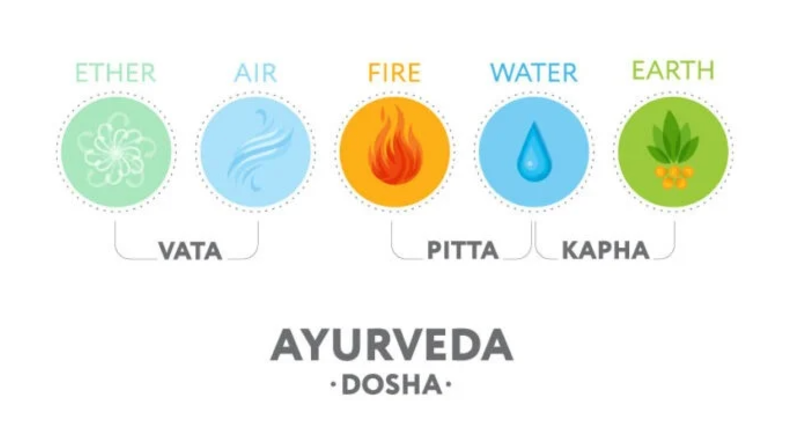
In Ayurveda, every individual has a unique constitution, often referred to as their dosha. The three primary doshas – Vata, Pitta, and Kapha – govern different aspects of our physical and mental well-being. Each dosha is associated with specific characteristics, and understanding these can help individuals align their lifestyle and diet to achieve a balanced, healthy life.
Key Points to Understand Dosha Types:
- Vata Dosha: Characterized by qualities of dryness, lightness, and coolness. Individuals with a dominant Vata dosha tend to be more energetic, creative, and quick in nature.
- Pitta Dosha: Associated with heat, intensity, and transformation. People with Pitta as their dominant dosha are typically ambitious, focused, and driven.
- Kapha Dosha: Governed by qualities of heaviness, stability, and coldness. Kapha types are often calm, grounded, and have strong physical endurance.
How to Determine Your Dosha Type:
To determine which dosha predominates in your body, it’s essential to undergo personalized counseling. This process includes:
- Dietary Recall: Keeping track of your food intake over a period (24 hours, 3 days, 1 week) helps to understand your food preferences and how they correlate with your dosha.
- Counseling and Observation: A professional will assess your physical and emotional characteristics to help classify your dosha. For instance, a Pitta type tends to prefer foods that are sweet, bitter, and astringent, whereas Kapha types are inclined toward pungent and bitter foods.
Importance of Dosha-Specific Eating:
Nature provides us with food that naturally aligns with our dosha type. By consuming foods suited to your body type, you can balance the inherent excesses of your doshas and maintain health. However, consuming foods that are contrary to your dosha can lead to an imbalance, resulting in toxicity and illness.
Potential Consequences of Incorrect Eating:
Eating the wrong foods, even if they are nutritious, can cause the following:
- Increased Toxicity: Foods that are not suitable for your dosha can create toxins in the body.
- Accelerated Disease Progression: Over time, an imbalance in diet may lead to health issues such as digestive problems, skin conditions, and more serious diseases.
- Long-Term Impact: While negative effects may not be immediately noticeable, they can manifest as chronic illnesses and other health complications in the long run.
The Role of Inflammation in Modern Diets:
Currently, there is a growing trend toward inflammation-reducing diets, often referred to as anti-inflammatory diets. These diets aim to reduce inflammation caused by environmental, medical, or lifestyle factors. However, the key to maintaining health goes beyond following trendy diets. It’s important to consider an individual’s dosha type and how it interacts with certain foods.
Why Dosha-Based Eating Works:
- Customized Nutritional Advice: By identifying an individual’s dosha, specific foods can be recommended that promote balance and well-being.
- Avoiding Harmful Foods: Even foods with high nutritional value can be harmful if they don’t suit a person’s dosha. For instance, a person with a Pitta imbalance should avoid spicy, fried foods that may exacerbate their condition.
- Improved Health Outcomes: When individuals follow a diet tailored to their dosha type, they can see significant improvements in overall health.
The Importance of Avoiding Unsuitable Foods:
- Preventive Health: Avoiding foods that don’t suit your body type can prevent many common health problems.
- 50% Improvement: By simply eliminating foods that are not suitable, individuals can improve their health by up to 50%.
- Focusing on Balance: Once you avoid foods that don’t align with your dosha, it becomes easier to treat other external factors that might be affecting your health, such as stress or environmental conditions.
To truly optimize health, understanding one’s dosha is essential. The foods that suit your body type play a crucial role in maintaining balance and preventing diseases. By learning about your dosha and eating according to what is most beneficial for your body, you can make significant strides toward long-term well-being. So, focus on your body’s specific needs, and adjust your diet accordingly to achieve the best health outcomes.
Understanding Vata Dosha and Its Food Recommendations in Naturopathy

In Ayurveda, the concept of doshas plays a crucial role in understanding an individual’s constitution and health. There are three primary doshas: Vata, Pitta, and Kapha, each representing a combination of the five elements—earth, water, fire, air, and ether (space). In this article, we will focus on Vata dosha, its characteristics, and how diet can help balance it.
What is Vata Dosha?
Vata dosha is primarily associated with the elements of ether (space) and air. It governs all movement in the body, such as nerve impulses, respiration, circulation, digestion, and even creativity. People with a dominant Vata dosha tend to have a lean body type, dry skin, and may exhibit a quick, restless nature. The main qualities of Vata dosha are:
- Cool
- Dry
- Rough
- Light
Effects of Imbalanced Vata Dosha
When the Vata dosha is aggravated or imbalanced, it can manifest in several health issues. Some common signs of an aggravated Vata include:
- Dry skin and hair
- Constipation or digestive issues
- Anxiety and nervousness
- Sleep disturbances
- Joint pain and stiffness
If Vata individuals consume too many pungent or bitter foods over time, it can lead to rapid aging and degenerative diseases. These individuals may also experience stress or depression due to improper dietary choices. In such cases, they may assume these problems stem from emotional or mental stress, but the root cause often lies in their diet.
The Right Diet for Vata Dosha
To bring balance to Vata, it is essential to provide foods that counteract its inherent qualities. Here are some dietary recommendations:
- Warm foods: Vata individuals should consume warm, nourishing meals to counteract their body’s tendency to be cool.
- Moisturizing foods: Foods that hydrate the body help to balance the dryness of Vata. Including healthy fats in the diet is beneficial.
- Grounding foods: To offset Vata’s lightness, grounding foods such as grains, root vegetables, and healthy fats like ghee or butter are ideal.
Recommended Foods for Vata Dosha
To restore balance to Vata dosha, the following foods are highly recommended:
- Fruits: Sweet and ripe fruits such as bananas, apples, pineapples, papayas, and melons are excellent choices. Dried fruits like figs, raisins, and prunes can also be included in moderation.
- Nourishing grains: Warm, moist grains like rice, oats, and wheat provide grounding and hydration.
- Healthy fats: Butter, ghee, and olive oil are great sources of healthy fats that help lubricate the body and soothe dryness.
- Root vegetables: Potatoes, carrots, sweet potatoes, and beets are grounding and nourishing.
- Nuts and seeds: Almonds, walnuts, and sesame seeds are rich in healthy fats and protein, offering hydration and stability.
Foods to Avoid for Vata Dosha
Certain foods should be avoided or minimized in a Vata-predominant diet, as they can aggravate the dosha further. These include:
- Cold and dry foods: Raw salads, cold drinks, and dry snacks can worsen the dryness and coolness of Vata.
- Caffeinated drinks: Coffee, tea, and other stimulating beverages can increase anxiety and restlessness.
- Bitter and pungent foods: Excessive consumption of bitter and spicy foods can cause imbalances and lead to digestive problems.
- Excessively processed foods: Highly processed or junk foods lack the nourishing qualities needed to soothe Vata.
Timing of Meals for Vata Dosha
- Eat regularly: Vata individuals should eat at regular intervals and avoid going hungry for long periods. Skipping meals can affect their digestion and energy levels.
- Fruit consumption: Fruits can be consumed before or after meals to maintain digestive health. Sweet fruits, in particular, are best for balancing Vata.
Understanding the dietary needs of Vata dosha is an essential aspect of maintaining balance and preventing health problems. By focusing on warm, nourishing, and grounding foods while avoiding cold, dry, and processed options, individuals can support their body’s natural movement, digestion, and overall well-being. Ayurveda teaches us that maintaining balance in our doshas through proper diet and lifestyle can lead to better health, vitality, and longevity.
Pitta Dosha: Understanding Its Dietary Needs and Restrictions

Pitta dosha is one of the three primary doshas in Ayurvedic medicine, representing a combination of the elements fire and water. Individuals with a predominant pitta dosha have a highly active metabolism, characterized by higher levels of hydrochloric acid (HCL) in the stomach. This allows for excellent digestion, metabolism regulation, body temperature control, hunger cues, intelligence, and hormonal function.
Digestive Characteristics of Pitta Dosha
- Strong Digestion: Pitta types are known for their excellent digestion and ability to consume large quantities of food without experiencing discomfort like diarrhea, constipation, or stomach pain. Their digestion operates smoothly, allowing them to enjoy a wide range of foods.
- High Metabolism: Pitta individuals have a higher basal metabolic rate (BMR), meaning they can digest food more efficiently and are less likely to gain weight, even when consuming large amounts of food.
Recommended Foods for Pitta Dosha
To support pitta dosha, foods should be cool or mildly warm, avoiding anything too spicy, sour, or salty, as these can aggravate the excess acid in the stomach. During warmer seasons, pitta individuals can benefit from refreshing, light foods like salads or fruit juices.
- Fruits: Sweet fruits such as avocado, apple, coconut, melons, oranges, dates, figs, mangoes, pomegranates, and cherries are ideal. Avoid dried fruits, as they can increase the metabolic rate, which is already high in pitta types.
- Vegetables: Sweet or bitter vegetables such as cabbage, cucumber, zucchini, mushrooms, asparagus, lettuce, cauliflower, and peas are recommended.
- Grains: Barley, cooked oats, wheat, and rice are suitable grains for pitta types.
- Legumes: All legumes are beneficial for pitta dosha, except lentils, which should be avoided.
- Sweeteners: Brown sugar and honey are recommended. Simple sugars should be avoided to prevent aggravating the pitta condition.
- Spices: Mild spices like cilantro, turmeric, fennel, black pepper, and cardamom are acceptable in small amounts.
- Dairy and Alternatives: Goat or cow milk cheese, clarified butter, unsalted butter, and soy-based products like tofu or soya milk are excellent choices for pitta individuals.
Foods to Avoid for Pitta Dosha
Certain foods should be avoided by individuals with pitta dosha to maintain balance:
- Sour and Pungent Foods: Sour fruits, pungent vegetables, and root vegetables like radishes and eggplants should be avoided.
- Fermented and Processed Foods: Foods such as yeast bread, millet, and salted butter should be minimized.
- Dairy Products: Yogurt, sour cream, and hard cheeses are not suitable for pitta types as they may aggravate acidity levels.
- Other Avoidances: Mustard, olives, and turnips can disrupt the delicate balance of pitta dosha and should be avoided.
A balanced diet for pitta dosha should focus on cooling, light, and mildly spiced foods. By avoiding overly spicy, sour, and salty items, and incorporating more cooling foods and gentle spices, pitta types can maintain their digestive health, energy, and overall well-being. The key is to cater to their higher metabolic rate while providing nourishment that does not exacerbate their natural tendencies toward acidity and heat.
Understanding Kapha Dosha and Its Dietary Recommendations

Kapha dosha, one of the three primary doshas in Ayurvedic medicine, is composed of the elements earth and water. It represents qualities such as heaviness, stability, slowness, coolness, and softness. Individuals with a predominance of Kapha dosha often experience characteristics that reflect these qualities. Their metabolism tends to be slower, and they may feel sluggish or lethargic, particularly after eating large meals. Understanding the properties of Kapha dosha can guide dietary choices, helping maintain balance for those with this constitution or those experiencing imbalances.
Characteristics of Kapha People
- Physical Traits: People with Kapha dosha typically have larger, more solid body structures. They often have smooth, oily skin and thick hair. Their movements are generally slower, and they are less prone to irritability or emotional fluctuations.
- Metabolism: Kapha individuals have a slower metabolism and can feel full on smaller portions of food. However, their digestion can be sluggish, making them prone to weight gain and water retention if not mindful of their food choices.
- Emotional Traits: Kapha types are generally calm, compassionate, and loving. However, they may struggle with attachment, laziness, or lethargy, particularly when emotionally overwhelmed or stuck in routine patterns.
Kapha Dietary Guidelines
A balanced diet is key to maintaining harmony in Kapha individuals. Their dietary choices should focus on foods that counteract the heavy, cool, and slow qualities of Kapha. Below are the recommended foods and foods to avoid for Kapha dosha.
Foods to Favor
- Light and Warm Foods: Kapha types should favor light, warm, and dry foods. This includes lightly cooked or raw fruits, fresh salads, and lightly steamed vegetables. Spicy, bitter, and astringent foods help stimulate digestion and reduce the excess moisture and heaviness of Kapha.
- Spicy Vegetables: Bitter and spicy vegetables such as cabbage, carrots, eggplants, mushrooms, Brussels sprouts, garlic, peas, fennel, and cauliflower are excellent choices. These vegetables stimulate metabolism, helping balance Kapha’s sluggish digestion.
- Whole Grains: Moderate consumption of whole grains such as barley, millet, oats, and corn is ideal. These grains are high in fiber and have a lower calorie density, making them beneficial for Kapha types prone to weight gain.
- Legumes and Beans: Most legumes, except for white beans and lentils, are beneficial for Kapha individuals. Legumes provide protein and fiber, aiding digestion without contributing to weight gain.
- Fruits: Fresh fruits such as apples, cherries, mangoes, berries, figs, and plums are light, high in water content, and help detoxify the body. These fruits counterbalance the heavy and dense qualities of Kapha.
Foods to Avoid
- Dairy Products: Heavy dairy products like cheese and yogurt should be consumed in moderation or avoided, as they can aggravate Kapha imbalances by adding to the body’s natural heaviness.
- Fatty and Oily Foods: Foods high in unhealthy fats, such as deep-fried foods, should be avoided. Excess oil and fat can increase Kapha’s tendency for weight gain and sluggish digestion.
- Sugary Foods: Refined sugars should be limited, as they add to the heaviness and sluggishness associated with Kapha.
Cooking Methods
- Dry and Light Cooking: Cooking methods that dry and heat food are more beneficial for Kapha dosha. Baking, grilling, broiling, and sautéing are preferable over steaming or frying. These methods help reduce moisture and enhance the metabolism of Kapha individuals.
Eating Habits
- Avoid Overeating: Overeating can worsen sluggishness and contribute to weight gain for Kapha types. Eating in moderation and maintaining a balanced routine helps sustain energy levels.
- Spicy Foods: Incorporating warming spices such as ginger, turmeric, black pepper, and mustard seeds can help balance Kapha’s coolness and heaviness.
- Hydration: Kapha individuals should focus on hydration but avoid excessive cold or ice-cold water, as it can dampen digestive fire. Opt for room temperature or warm water, and herbal teas for better digestion.
In Ayurveda, understanding one’s dosha and adjusting the diet accordingly is essential for maintaining optimal health. For Kapha types, focusing on warm, light, and dry foods rich in fiber and mildly spiced can help counterbalance the heavy and slow qualities of their nature. By avoiding foods that increase moisture and sluggishness, Kapha individuals can stay energized, maintain a healthy weight, and promote overall wellness.
Ayurvedic Principles for Digestion and a Healthier Lifestyle

Ayurveda, the ancient Indian system of medicine, emphasizes maintaining balance between the body’s doshas (Vata, Pitta, and Kapha) for optimal health. One of the key areas Ayurveda focuses on is digestion, which plays a fundamental role in maintaining overall well-being. This article explores some Ayurvedic principles that help improve digestion and lead to a healthier lifestyle.
Understanding Doshas and Their Impact on Digestion:
Ayurvedic principles categorize the body into three doshas: Vata, Pitta, and Kapha. Each dosha represents a unique combination of bodily characteristics and governs specific physiological processes. The balance between these doshas is crucial for maintaining good health. Here’s how these doshas impact digestion:
- Kapha Dosha
- The first hour after eating, Kapha dosha is on the rise. This period is characterized by a feeling of heaviness and dullness, which can persist for two to four hours after consuming food.
- It is important to allow sufficient time for digestion, as Kapha dosha takes longer to process food. Therefore, snacking in between meals is not advisable as it can disrupt the digestive cycle.
- Pitta Dosha
- After the initial rise in Kapha dosha, Pitta dosha takes control of digestion during the following two to four hours. This phase is associated with increased internal heat and a strong digestive capacity.
- During this period, it’s important to allow the digestive process to complete without interference. Overeating or consuming heavy foods can hinder the digestive process and lead to discomfort.
- Vata Dosha
- Finally, four to five hours after a meal, Vata dosha rises. This phase is characterized by a light, hungry feeling, signaling that digestion has been completed.
- Vata dosha plays a key role in ensuring proper nutrient absorption and maintaining gut motility. It is essential to allow this process to occur naturally and not disrupt it with snacking or excessive food intake.
Dosha-Specific Dietary Principles:
Understanding how each dosha affects digestion allows for the creation of dosha-specific dietary principles. Here’s an overview:
- Kapha Dosha
- For individuals with Kapha dosha, meals should be spaced out with longer intervals to allow time for proper digestion. Avoid snacking as it can interfere with this process.
- Kapha dosha tends to take longer to break down food, so it’s important to give enough time between meals. Heavy, oily, or sweet foods can aggravate Kapha dosha and lead to sluggish digestion. Opt for light, easily digestible foods like steamed vegetables, lean proteins, and whole grains to maintain balance.
- Pitta Dosha
- For those with Pitta dosha, meals should be consumed at regular intervals without skipping any to maintain digestive balance. Foods that are overly spicy, sour, or oily can increase Pitta dosha, leading to digestive discomfort.
- To maintain digestive health, focus on a diet rich in cooling, alkaline foods like leafy greens, fruits, and whole grains. Avoiding hot, pungent, and acidic foods can help reduce excess Pitta.
- Vata Dosha
- For individuals with Vata dosha, it’s important to avoid long gaps between meals. Consuming small, frequent meals can help maintain digestive balance. Foods that are light, warm, and moist are ideal for Vata dosha.
- Heavy or dry foods can aggravate Vata dosha, leading to bloating, gas, and irregular bowel movements. Foods like cooked grains, root vegetables, and healthy fats are recommended to support Vata dosha digestion.
Effect of Doshas on Digestion:
The doshas play a significant role in how food is processed and absorbed by the body. Each dosha affects digestion differently:
- Kapha: The first hour after eating, Kapha dosha is on the rise. This is a period where a feeling of heaviness and dullness can be experienced. Allowing sufficient time for digestion is essential to prevent sluggishness.
- Pitta: During the next two to four hours, Pitta dosha takes control. This phase is characterized by strong digestive capacity, but excessive heat can lead to discomfort. It’s important to consume cooling, light foods to maintain balance.
- Vata: Finally, Vata dosha rises after four to five hours. This phase is marked by a light, hungry feeling, signaling the completion of digestion. Snacking during this time can disrupt the natural digestive process.
Ayurvedic Guidelines for Food Combinations:
When it comes to Ayurveda, food combinations play a vital role in maintaining digestive health. Here are some key principles to follow:
- Fruits Alone
- According to Ayurveda, fruits should be eaten alone and not combined with other foods like protein or cereals. The digestion process for carbohydrates is different from that of fruits, and combining them can lead to digestive discomfort.
- Eating fruits alone ensures that the natural enzymes required for fruit digestion are not hindered by other foods. This practice helps maintain the digestive process and allows for optimal nutrient absorption.
- Seasonal Foods
- Ayurveda emphasizes the importance of consuming seasonal foods. The soil microbial content changes with the seasons, affecting the nutritional value of fruits and vegetables. A seasonal diet helps repopulate gut microbes with the right bacteria needed for optimal health.
- This practice ensures that the digestive system remains balanced and healthy by incorporating foods that are naturally suited to each season.
- Right Food Combinations
- Some foods, like protein and grains, are best consumed separately to avoid disrupting digestion. Combining them can lead to sluggish digestion and bloating.
- Ayurveda suggests eating foods that complement each other’s digestive process, such as vegetables with proteins, to maintain harmony between the doshas and digestive health.
The Right Combination for Digestive Health:
Ayurveda recognizes that different individuals have different digestive needs. Here are some simple dietary guidelines to ensure you are eating the right combinations of food:
- Fruit Should Be Eaten Alone
- Fruit should be consumed alone and not combined with any other food item like protein or grains. This helps maintain optimal digestion and prevents bloating or discomfort.
- Avoid Heavy Meals
- Avoid overeating or consuming heavy meals, as this can lead to sluggish digestion. Light, easily digestible foods like steamed vegetables, lean proteins, and whole grains are ideal for maintaining balance.
- Regular Meal Timing
- Ensure that you eat meals at regular intervals to allow for proper digestion. Skipping meals or long gaps between them can disrupt the natural digestive process and lead to discomfort.
Ayurvedic principles offer a holistic approach to maintaining digestive health. By understanding your dosha type and incorporating the right food combinations, you can support optimal digestion and overall well-being. These principles not only help balance the doshas but also ensure that the digestive system functions smoothly, leading to improved health and vitality.
Rules for Combining Foods: A Guide to Better Digestion
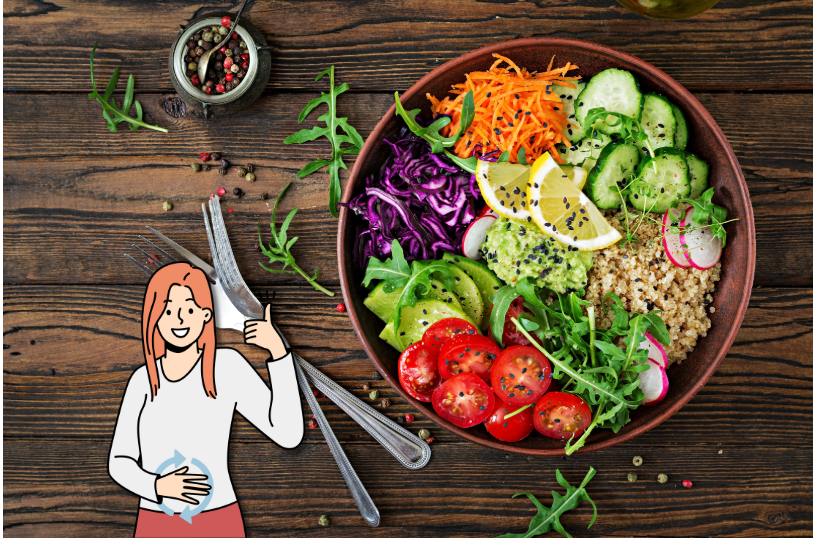
When it comes to eating, the combination of foods plays a crucial role in ensuring efficient digestion and overall well-being. Many health authorities have recognized and accepted certain rules for combining food that help prevent digestive disturbances. Let’s explore these simple, widely-accepted rules for combining food in a way that supports optimal digestion.
Rule 1: Avoid Combining Acidic Foods with Starchy Foods
- Why: Acidic foods (like citrus fruits) and starchy foods (like potatoes, bread, and cereals) can disrupt digestion when eaten together. Starches require an alkaline environment to break down, and acidic foods can interfere with this process.
- What to do:
- Avoid: Pairing acidic foods (e.g., oranges, lemons, tomatoes) with starchy foods.
- Best practice: Consume acidic foods alone or with healthy fats (e.g., avocado) to balance the stomach environment and promote smoother digestion.
- Example: Enjoy an orange with avocado for a better digestion experience, rather than with a starchy meal like bread or potatoes.
Rule 2: Avoid Combining Acidic Foods with Protein-Rich Foods
- Why: When acidic fruits are eaten with protein-rich foods (like meat, eggs, and beans), the acid can cause proteins to coagulate, making them harder to digest. This results in slower digestion and discomfort.
- What to do:
- Avoid: Combining protein-rich foods with acidic fruits (like oranges, pineapples, or tomatoes).
- Best practice: Separate acidic fruits from proteins, or consume them at different meals for smoother digestion.
- Example: Have your protein-rich lunch (e.g., grilled chicken or beans) without pairing it with an acidic fruit. Enjoy fruits separately, or pair them with milder foods.
Rule 3: Select Foods That Digest in Similar Time Frames
- Why: Different foods take varying amounts of time to digest. Combining foods with similar digestion times helps ensure your digestive system isn’t overloaded, preventing discomfort.
- What to do:
- Avoid: Pairing foods with drastically different digestion times (e.g., slow-digesting proteins with quick-digesting carbohydrates).
- Best practice: Plan meals using foods that digest at similar rates. For instance, pair rice with poached eggs or toast with boiled potatoes.
- Example: If you have a busy day ahead, select foods that take 2-3 hours to digest (e.g., bread and apples) to keep you energized without overwhelming your digestive system.
To improve digestion, it’s not just about selecting balanced meals with carbohydrates, proteins, vitamins, and minerals. It’s also important to consider how long each food item takes to digest. By following these food combination rules, you can optimize your digestion and enjoy a healthier, more comfortable eating experience.
Principles of Proper Food Combinations for Better Health
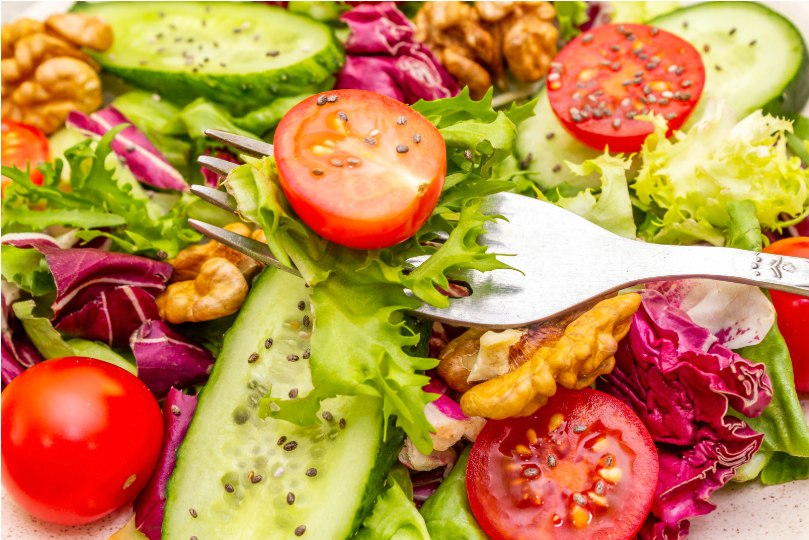
When it comes to nutrition, it’s not just about the foods we eat but also about how we combine them. Food combinations can significantly impact digestion and nutrient absorption, ultimately contributing to overall health. Let’s explore the key principles for combining foods correctly to improve digestibility, nutritional value, and health benefits.
1. Complementary Proteins
Complementary proteins refer to the combination of foods that provide all the essential amino acids our body needs. These amino acids are crucial for muscle building, immune function, and overall health.
- High Biological Value Proteins vs. Low Biological Value Proteins: Proteins are categorized based on their biological value. High biological value (HBV) proteins contain all the essential amino acids, while low biological value (LBV) proteins may lack one or more of these amino acids.
- Combining Animal and Plant Proteins: For example, pairing non-vegetarian foods like chicken, mutton, or liver with leafy greens such as spinach can enhance amino acid absorption. The vegetable provides the missing amino acids, making the protein more complete and digestible.
- For Vegetarians: To ensure they get all essential amino acids, vegetarians can combine plant-based proteins like tofu, paneer, or soya with other food sources rich in complementary amino acids. Sometimes, vegetarian diets may require supplements to fill any gaps in amino acids.
2. Balanced Macronutrients
A balanced meal should include a healthy combination of carbohydrates, proteins, and healthy fats. These macronutrients serve different purposes:
- Carbohydrates provide energy.
- Proteins support tissue repair and growth.
- Healthy Fats are essential for brain health and hormone regulation.
When combining foods, it’s essential to ensure that all three macronutrients are present in balanced proportions. For example, pairing whole grains like quinoa with lean proteins (such as chicken or lentils) and healthy fats (like olive oil or avocado) creates a well-rounded meal that supports digestion and provides long-lasting energy.
3. Synergistic Nutrients
Synergistic nutrient combinations refer to foods that enhance each other’s nutrient absorption when consumed together. This means that certain foods can work together to make nutrients more available to the body.
- Iron and Vitamin C: Iron is better absorbed when combined with vitamin C. For instance, pairing iron-rich foods like spinach or lentils with vitamin C-rich foods like citrus fruits (oranges, lemons) or bell peppers can increase iron absorption significantly.
- Tomatoes and Olive Oil: Lycopene, an antioxidant found in tomatoes, is better absorbed when consumed with healthy fats like olive oil.
By understanding synergistic combinations, you can enhance the nutritional value of your meals.
4. Digestive Harmony
Digestive harmony refers to pairing foods in a way that promotes smooth digestion and reduces discomfort.
- Heavy Foods and Easy Digestion: When eating heavy or rich foods, it’s important to pair them with foods that ease digestion. For example, after consuming spicy or fatty foods, drinking cold milk can help soothe the stomach and ease any discomfort from acidity or heartburn.
- Spicy Foods and Milk: While combining spicy foods with cold milk is generally not recommended from a culinary perspective, it can be helpful in treating immediate digestive discomfort. The cold milk helps neutralize acidity and calm the stomach.
- Digestive Discomfort: If you experience discomfort after eating, such as bloating or acidity, incorporating digestive-friendly foods like yogurt or ginger into your meal can help balance your digestive system.
5. The Importance of Timing in Food Combinations
While it’s essential to focus on food combinations, it’s also crucial to pay attention to digestion timing. Some foods digest faster than others, and eating foods that digest at different rates can cause discomfort or improper nutrient absorption.
- Foods That Digest Quickly: Foods like rice, boiled potatoes, eggs, and toast tend to stay in the stomach for about an hour.
- Foods That Digest Slowly: Foods such as bread, tapioca, and apples typically take around two hours to digest.
By understanding how long various foods take to digest, you can avoid pairing slow-digesting foods with fast-digesting ones, ensuring smoother digestion and better nutrient uptake.
When it comes to food combinations, it’s not just about making healthy food choices but also about how those foods work together in the digestive process. By following the principles of complementary proteins, balanced macronutrients, synergistic nutrients, and digestive harmony, you can optimize your digestion and improve nutrient absorption. Combining foods mindfully will help you feel more energized and reduce discomfort, ultimately supporting your overall well-being.
Food Combinations for Better Health

Food combinations can play a vital role in improving digestion, enhancing nutrient absorption, and supporting overall health. When foods are paired in a way that complements their nutritional profile, they can provide even greater benefits than when eaten individually. Let’s explore some important principles and examples of food combinations that promote better health.
Protein-Rich Combinations
For those looking to increase protein intake, certain food combinations offer complete proteins, especially for vegetarians. Here are a few combinations to try:
- Beans and Rice: Together, beans and rice provide all the essential amino acids, making them a complete protein source.
- Lentils and Whole Wheat Bread: This combination is also rich in protein and helps in muscle repair and growth.
- Chicken and Quinoa: Chicken is a great source of lean protein, and quinoa adds additional protein and essential amino acids.
- Fish and Brown Rice: Fish is an excellent source of protein, and brown rice complements it with fiber and nutrients.
These combinations not only enhance the protein content of your meals but also provide a variety of vitamins and minerals that support overall health.
Vitamin and Mineral Enhancers
Some foods are better absorbed when combined with others that enhance their nutritional value. Here are a few examples of food combinations that boost the absorption of vitamins and minerals:
- Vitamin C and Iron: Vitamin C helps improve the absorption of iron, making it easier for the body to utilize iron-rich foods. A good combination would be spinach (rich in iron) paired with lemon juice (rich in vitamin C). Similarly, orange juice or sweet lime juice can help improve the absorption of iron from plant-based sources like lentils and beans.
- Vitamin D and Calcium: Both of these nutrients are essential for bone health. Combining fatty fish (rich in vitamin D) with calcium-rich foods like dairy products or leafy greens will enhance bone-strengthening benefits.
- Beta-Carotene and Healthy Fats: Beta-carotene, found in foods like carrots, is better absorbed when paired with healthy fats like those found in avocados. These fats help in the absorption of fat-soluble vitamins such as vitamin A, which is important for vision and skin health.
Digestive-Friendly Combinations
Certain food combinations can aid digestion and promote gut health. These foods are easy on the stomach and help improve digestion:
- Banana and Almond Butter: This combination is not only rich in fiber but also in healthy fats, making it easy to digest while keeping you full.
- Oatmeal with Fruits and Nuts: Oatmeal is high in fiber, while fruits and nuts provide essential vitamins and minerals, supporting digestive health.
- Yogurt with Honey: This combination provides probiotics (from yogurt) and antioxidants (from honey), promoting healthy digestion.
- Ginger and Chicken: Ginger is known for its digestive properties, and when combined with chicken, it can enhance digestion and relieve bloating.
Antioxidant-Rich Combinations
Antioxidants help protect the body from oxidative stress and inflammation. Certain foods work well together to provide a boost in antioxidants:
- Berries and Green Tea: Both are rich in antioxidants. Pairing them together provides a powerful combination to fight free radicals and promote cellular health.
- Leafy Greens and Nuts: Leafy greens like spinach and kale are rich in antioxidants, and when paired with nuts like almonds, they provide a healthy dose of fat-soluble vitamins and minerals.
- Tomatoes and Avocado: Tomatoes are rich in lycopene, an antioxidant, and pairing them with avocado provides healthy fats that improve the absorption of this powerful nutrient.
Other Beneficial Combinations
- Fermented Foods and Whole Grains: Fermented foods like kimchi or sauerkraut paired with whole grains like idli or dosas support gut health by providing probiotics and fiber.
- Omega-3 Rich Foods and Antioxidant-Rich Foods: Foods like salmon, rich in omega-3 fatty acids, paired with antioxidant-rich foods like spinach, create a powerful duo that supports heart and brain health.
Food Combining Tips
When incorporating these combinations into your diet, it’s important to follow a few guidelines:
- Balance Your Plate: Ensure that each meal has a good mix of protein, carbohydrates, and healthy fats for optimal digestion and nutrient absorption.
- Eat Fresh: Fresh, whole foods are the best choice for nutrient absorption. Avoid overly processed foods that can hinder digestion.
- Pair Smartly: As discussed, certain foods are more beneficial when paired with others. Always look for ways to enhance the nutritional value of your meals by combining foods effectively.
By making thoughtful food combinations a part of your daily routine, you can enhance your overall health, improve digestion, and make the most out of the nutrients available in your meals. Experiment with these combinations and find the ones that work best for your body’s needs.
Understanding Food Combinations: The Right and Wrong Choices

In the realm of nutrition and health, food combinations play a crucial role in how our body processes and absorbs nutrients. While the right food combinations can improve digestion and overall health, the wrong ones can lead to digestive issues, nutrient deficiencies, flavor clashes, and even foodborne illnesses. It’s essential to understand the nuances of food pairing to optimize your health and avoid unnecessary complications.
The Right Food Combinations
Before diving into the wrong combinations, it’s important to note that the right food combinations are essential for maintaining good health. When food is paired correctly, it ensures proper digestion, nutrient absorption, and better energy levels. Some general principles to consider for creating healthy food combinations include:
- Protein + Non-Starchy Vegetables: Combining protein sources like lean meats or legumes with non-starchy vegetables like spinach or kale helps in proper digestion without overloading the stomach.
- Starches + Vegetables: Starchy foods like potatoes or rice can pair well with vegetables, which provide fiber to slow down the digestion of carbohydrates and help maintain steady energy levels.
However, the opposite—wrong combinations—can cause discomfort, so let’s explore those.
Wrong Food Combinations: What to Avoid
While not all food combinations are harmful to everyone, certain pairings can cause digestive issues, nutrient imbalances, and discomfort. It’s important to note that food intolerances vary from person to person, so a combination that affects one person may be harmless to another.
Here are some examples of combinations that are often problematic:
1. Food Combinations Leading to Digestive Issues
Some food pairings are known to cause flatulence, bloating, or stomach irritation:
- Beans + Broccoli: Both are healthy but can create digestive discomfort due to their high fiber content, which can lead to gas and bloating.
- Dairy + Citrus Fruits: Combining milk with citrus fruits like oranges or lemons can curdle milk in the stomach and cause indigestion.
- Spicy Foods + Carbonated Drinks: This combination can irritate the stomach lining, causing discomfort or acid reflux.
2. Nutrient Deficiencies Due to Poor Combinations
Certain foods inhibit the absorption of important nutrients, leading to deficiencies over time:
- Coffee + Iron-Rich Foods: Consuming coffee with iron-rich foods like spinach or legumes can hinder iron absorption, leading to deficiencies, especially in individuals who already struggle with low iron.
- Spinach (Oxalates) + Calcium-Rich Foods: Spinach contains oxalic acid, which can bind to calcium, reducing its absorption in the body and potentially leading to calcium deficiencies.
- High Phytate Foods (Beans) + Zinc: Beans are rich in phytates, which can interfere with zinc absorption, leading to a potential zinc deficiency.
These nutrient imbalances are often subtle at first, but over time, they can manifest as health issues such as anemia or weak bones.
3. Flavor Clashes: Tasting the Wrong Combinations
Not all food combinations are harmful to the body, but some simply clash in terms of flavor and texture, making meals less enjoyable. Here are a few pairings to avoid for a better culinary experience:
- Strong-Tasting Fish + Sweet Fruits: The strong, often pungent taste of fish does not pair well with the sweetness of fruits like mangoes or apples, creating an unpleasant combination.
- Pungent Cheeses + Delicate Herbs: Strong cheeses like blue cheese can overpower the subtle flavors of delicate herbs, leading to a clash of tastes.
- Spicy Foods + Mild Desserts: Mixing spicy foods with desserts can confuse the palate, resulting in an unsatisfactory eating experience.
4. Health Risks from Certain Food Pairings
Some food combinations can pose serious health risks, particularly when hygiene and food handling practices are not followed:
- Raw Meat + Ready-to-Eat Foods: Combining raw meats with ready-to-eat foods, like salads or sandwiches, can lead to cross-contamination and increase the risk of bacterial infections.
- Unripe or Raw Sprouts + Immune-Impaired Individuals: Raw or undercooked sprouts can harbor harmful bacteria, making them dangerous for individuals with compromised immune systems.
- Leftover Rice + Improper Reheating: Storing rice improperly or reheating it multiple times can encourage bacterial growth, leading to foodborne illnesses.
Additionally, certain food combinations can increase the risk of chronic health issues:
- Excessive Sugar + Processed Meats: Consuming high amounts of sugar with processed meats can increase the risk of heart disease and other chronic conditions.
- High Sodium + High Potassium: Combining high sodium with high potassium foods can cause electrolyte imbalances, leading to potential kidney issues over time.
- Fried Foods + High-Fat Sauces: This combination can lead to excessive calorie intake, contributing to weight gain and increasing the risk of obesity and related health problems.
Individual Intolerances and How to Personalize Food Combinations
Everyone has a different tolerance level for certain food combinations. While some people may be able to consume foods that others cannot, it’s important to pay attention to how your body reacts to various food pairings. Here are some tips to personalize your food combinations:
- Listen to Your Body: If you experience bloating, discomfort, or other digestive issues after eating certain foods together, it’s best to avoid those combinations.
- Experiment with Smaller Portions: If you are unsure whether a combination works for you, start by consuming smaller portions of the foods together and observe any changes in your digestion or overall health.
- Consult a Professional: If you have ongoing digestive issues or nutrient deficiencies, it’s important to seek advice from a healthcare provider or nutritionist who can guide you on suitable food pairings.
Additional Considerations for Certain Food Combinations
- Fruits and Milk: It’s generally advised to avoid combining fruits and milk, especially if the fruits are acidic. This combination can lead to fermentation in the stomach, causing bloating and discomfort. However, some fruits like mangoes can pair well with milk due to their sweetness.
- Time of Consumption: The effectiveness of certain food combinations can also depend on the time of day or your activity level. For example, a combination of heavy and light foods may work better at different times based on your body’s energy demands.
By being mindful of food combinations and understanding how they affect your body, you can make healthier choices and avoid unnecessary discomfort. While not all wrong combinations lead to severe health problems, it’s always best to listen to your body and make informed decisions based on your personal needs.


